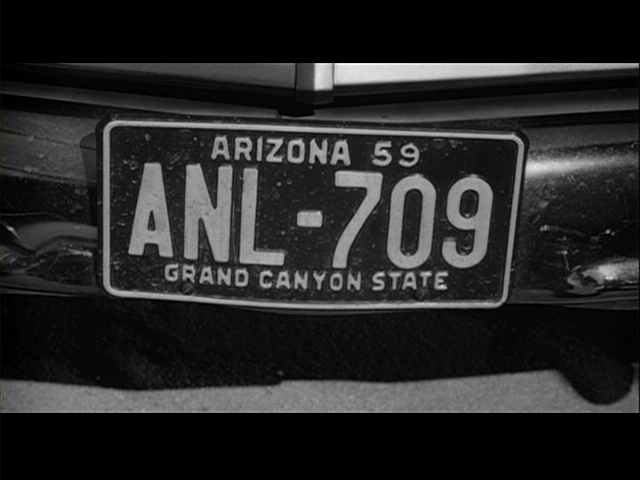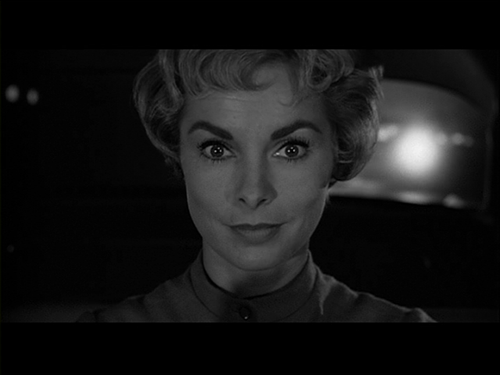Through the Looking Glass
- Swapping Loyalties
- Mirrors
Committing Crime and Exacting Punishment
- Rear Window
- Vertigo
- Psycho
Bombarding the Bombshell
Conclusion
References
Phallic Anamorphosis
In his essay, "The Hitchcockian Blot" Slavoj Žižek details three filmmaking methods, the oral, the anal, and the phallic, each one having its own was of using montage to deviler information to the audience. To explain each method more thoroughly, I've included in red italic an example of my own design.
In oral filmmaking, montage operates by presenting a simple series of events to be internalized by the audience. This method is comparable to the slapstick film, where one could see the woman would throw the banana peel, the peel landing on the floor, and a man slipping and falling on the discarded wrapping. Here “the montage has no function in organizing narrative tensions” but keeps the audience enthralled with the illusion of continuous action (Žižek 123).
In anal filmmaking a new kind of montage enters. “It cuts up, fragments, and multiplies the action; the illusion of homogenous continuity is forever lost." The benign action of the woman peeling the fruit is run parallel to the image of another man, a relative of hers, in another location putting on a condom. Two lines of action are now introduced that appear to exist within the same moment in time. Montage can combine elements of a wholly heterogeneous nature and thus create new metaphorical meaning having nothing whatsoever to do with the ‘literal’ value of its component parts ( Žižek 124). Now perhaps the woman eating the banana is representative of sexual desires for that relative, a symbolic internalization she could never otherwise achieve.
In phallic filmmaking, compositions which could once be interpreted as wholesome, common, everyday events are now fronts for the terrifying realities the truly embody. The banana is eaten and the peel is thrown, and the passerby falls as the relative reaches his climax, but now the very action of eating the fruit takes on darker implications. Perhaps the relative has just sealed his undoing, and the biting of the phallic fruit represents his impending symbolic castration. In this method, ‘everything becomes suspicous’…the ‘true’ action is repressed…presented in the form of the subject’s desires, hallucinations, suspicions, obsessions, feelings of guilt. What we actually see becomes nothing but a deceptive surface beneath which swarms an undergrowth of perverse and obscene implications (Žižek 124).
Musically we see the use of phallic methodology in Herrmann's prelude cue. As seen in the opening titles, the music hits the audience with an upbeat, energetic rhythm, getting our attention. It isnt until we hear the same cue used in Marion's escape from Phoenix that we realize its staccato opening notes not only generate a captivating energy, but the feeling of paranoia. See how the music is used in this montage from The Making of Psycho (Universal 1997) to generate suspense and intrigue.

In an analysis of the mise-en-scene, one asks why the letters ANL begin Marion’s license plate number. Looking at the plate in terms of Žižek’s “anal” filmmaking method, we can interpret the license plate not only as a clever, if not vulgar, play on otherwise arbitrary letters, but a disclaimer as to what the audience is about to witness : what internal conflict (and the nature of such) we are about to listen in on inside Marion’s head.
The bits of conversation we hear inside of her as she escapes Phoenix seem to be ‘real’ upon first viewing the film, but are actually the application of “anal” filmmaking. New metaphoric meaning is derived from the existing components such as Lowery’s paranoia, Cassidy’s cowboy-like boisterous flirtatiousness, and the car salesman’s suspicions (which were outmatched only by his greed, his readiness to accept the suspect cash). With the characters personalities and motivations now known, Hitchcock then recombines the literal values of the components to insinuate Marion’s darker personal problem.

With the character elements in place, the imaginary conversations are not a suggestion of impending incrimination and capture, but a “phallic” indication of Marion’s own slide into psychosis—an “oral” representation of the very slide Norman must have traversed years earlier (Žižek 124).